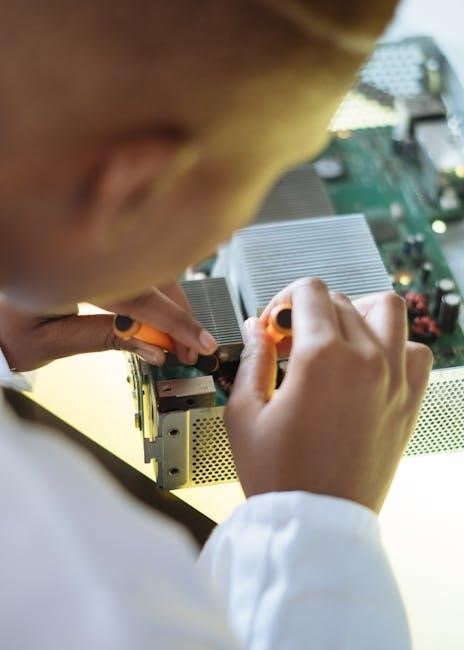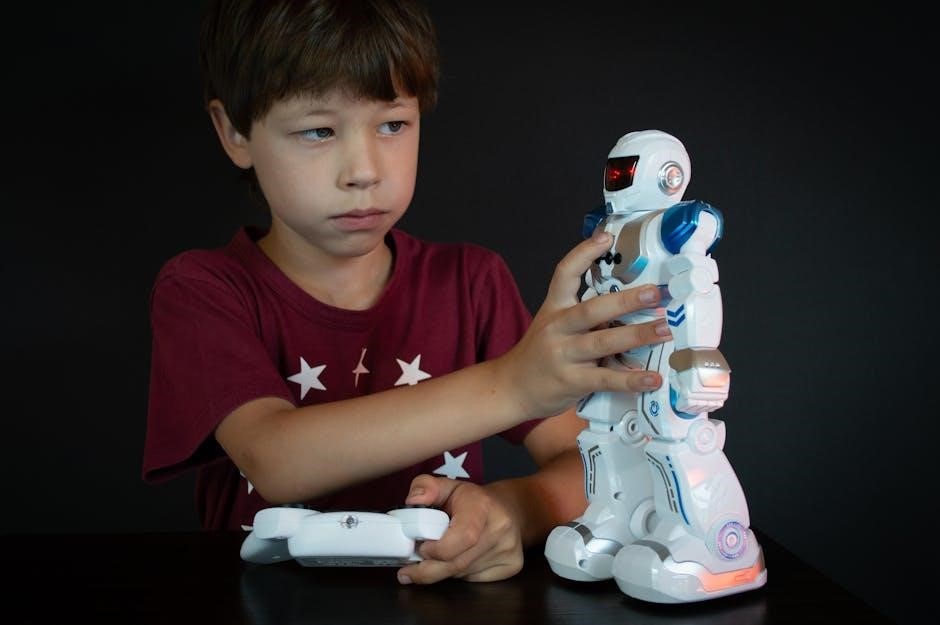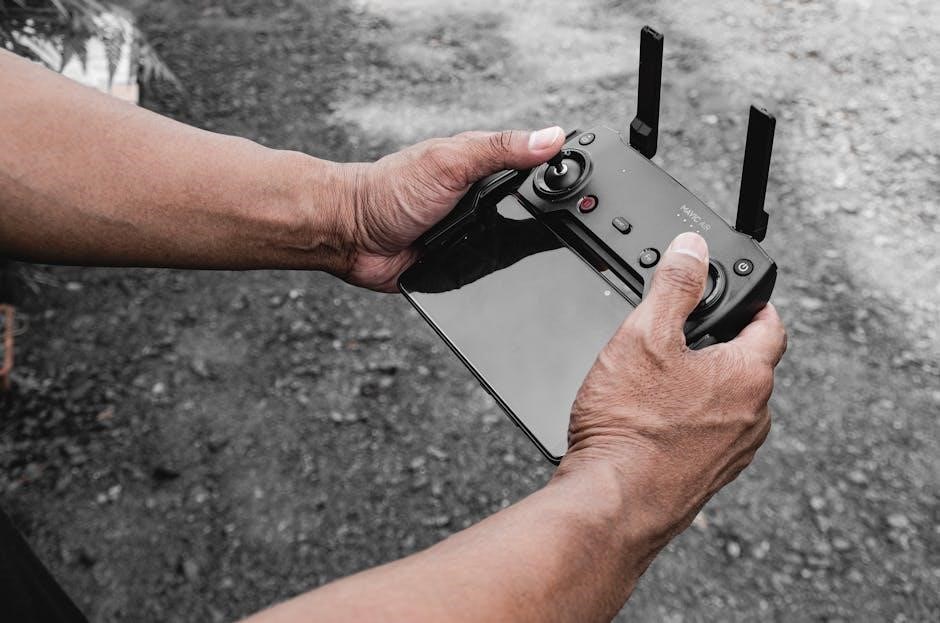ke2 controller manual pdf

Welcome to the KE2 Controller Manual PDF, your comprehensive guide for installing, operating, and maintaining the KE2 controller. This manual provides essential guidelines, safety tips, and troubleshooting solutions to ensure optimal performance and energy efficiency.
1.1 Overview of the KE2 Controller
The KE2 Controller is a versatile and advanced refrigeration control system designed for medium-temperature applications with air defrost capabilities. It simplifies refrigeration control by combining the functions of a thermostat and defrost timer, reducing complexity and wiring. Available in models such as the KE2 Temp Defrost, KE2 Evaporator Efficiency, and KE2 Low Temp Plus, this controller offers adaptive defrost technology and energy-efficient operation. Its user-friendly interface and compatibility with the KE2 Local Area Dashboard make it a reliable solution for commercial refrigeration systems.
1.2 Importance of the Manual for Installation and Operation
This manual is crucial for the safe and efficient installation and operation of the KE2 Controller. It provides detailed steps, safety precautions, and troubleshooting tips to ensure proper setup and maintenance. By following the guidelines, users can maximize the controller’s energy-saving features, such as adaptive defrost and fan management, while minimizing errors. The manual also serves as a quick reference for common operations, ensuring optimal performance and extending the lifespan of the controller.
Features and Benefits of the KE2 Controller
The KE2 Controller simplifies refrigeration control with adaptive defrost, optimizing energy efficiency and integrating seamlessly with Local Area Dashboards for enhanced monitoring and management capabilities.
2.1 Simplified Refrigeration Control
The KE2 Controller streamlines refrigeration management by combining thermostat and defrost functions into a single, user-friendly interface. This design reduces wiring complexity and enhances functionality, ensuring precise temperature control. With adaptive features, the controller optimizes defrost cycles and fan operation, minimizing energy waste. Its intuitive setup allows for easy navigation and real-time adjustments, making it ideal for medium and low-temperature applications. The KE2 Controller also integrates seamlessly with the KE2 Local Area Dashboard, enabling remote monitoring and alarms for superior system management.
2.2 Adaptive Defrost Technology
The KE2 Controller features Adaptive Defrost Technology, which dynamically adjusts defrost cycles based on system demand. This intelligent system monitors temperature, humidity, and coil performance to minimize unnecessary defrosting, reducing energy consumption and preventing excessive ice buildup. By optimizing defrost intervals, the controller ensures consistent refrigeration performance while maintaining efficient operation. This adaptive approach not only saves energy but also extends equipment lifespan by reducing wear and tear from frequent defrost cycles.
2.3 Energy Efficiency and Cost Savings
The KE2 Controller is designed to optimize energy efficiency, reducing operational costs through advanced features like adaptive defrost and fan management. By minimizing unnecessary defrost cycles and precisely controlling compressor runtime, the system ensures maximum energy savings. Additionally, the controller’s ability to regulate superheat and space temperature further enhances efficiency, leading to lower energy bills and prolonged equipment lifespan. These features make the KE2 Controller a cost-effective solution for modern refrigeration systems.
2.4 Integration with KE2 Local Area Dashboard and Alarms
The KE2 Controller seamlessly integrates with the KE2 Local Area Dashboard (LDA), enabling real-time monitoring and control of your refrigeration system. This integration allows for advanced alarm management, email/text notifications, and data logging, ensuring prompt issue resolution. The LDA’s user-friendly interface provides centralized control, enhancing operational efficiency and reducing downtime. This integration capability ensures comprehensive system management and peace of mind for facility operators.

Types of KE2 Controllers
The KE2 Controller family includes the KE2 Temp Defrost, KE2 Evaporator Efficiency, and KE2 Low Temp Plus Defrost models, each designed for specific refrigeration applications.
3.1 KE2 Temp Defrost Controller
The KE2 Temp Defrost Controller is designed for medium-temperature refrigeration applications with air defrost capabilities. It combines the functions of a thermostat and defrost time clock, simplifying system control while reducing wiring complexity. The controller features a user-friendly interface and preset defrost schedules, allowing automatic defrost cycles throughout the day. It is compatible with the KE2 Local Area Dashboard for enhanced monitoring and control. The manual provides detailed installation, programming, and troubleshooting steps for optimal performance.
3.2 KE2 Evaporator Efficiency Controller
The KE2 Evaporator Efficiency Controller is an advanced, electronically operated device designed to optimize energy use in refrigeration systems. It precisely controls superheat, space temperature, and fan cycling, reducing compressor runtime. The controller also implements demand defrost, enhancing efficiency and system performance. With compatibility with the KE2 Local Area Dashboard, it offers remote monitoring and control. This controller is ideal for reducing energy consumption while maintaining optimal refrigeration system operation, making it a cost-effective solution for commercial applications.
3.3 KE2 Low Temp Plus Defrost Controller
The KE2 Low Temp Plus Defrost Controller is specifically designed for low-temperature applications, offering precise control and energy efficiency. It features adaptive defrost technology, optimizing defrost cycles based on system demand. This controller is ideal for demanding environments, ensuring consistent performance while minimizing energy consumption. With quiet operation and robust construction, it is suitable for applications requiring reliable low-temperature control. The KE2 Low Temp Plus Defrost Controller also integrates seamlessly with the KE2 Local Area Dashboard for enhanced monitoring and alarm management.

Installation Guidelines
Follow the step-by-step installation guide for the KE2 controller, including wiring diagrams and mounting instructions. Ensure compliance with safety guidelines for a secure setup.
4.1 Steps for Installing the KE2 Controller
Begin by powering off the system and ensuring all components are safe to handle. Mount the controller using the provided screws or clips. Connect the power supply, ensuring compatibility with the controller’s voltage requirements (120V/208-240V). Install sensors and wiring according to the diagram, securing connections tightly. Power on the controller and follow the introduction mode to complete initial setup. Refer to the parts list for included items like sensors, connectors, and screws. This ensures a smooth and secure installation process.
4.2 Wiring Diagrams and Connections
Refer to the wiring diagrams in the manual for precise connections. Ensure the controller is powered with 120V/208-240V AC. Connect sensors, such as temperature probes, to their designated inputs. Securely wire the solenoid voltage (12V-240V) via the liquid line solenoid relay. Verify all connections match the controller’s terminal layout. Use the provided spade connectors for secure wiring. Double-check connections to avoid errors and ensure proper communication between components. Follow the diagram closely for accurate installation and safe operation.
4.3 Mounting the Controller
Mount the KE2 controller securely on a flat surface using the screws provided in the accessories kit. Place the controller over the pre-installed mounting screws and tighten firmly. Ensure the unit is level to maintain proper operation. Avoid exposing the controller to direct moisture or extreme temperatures. Secure all connections before powering on. Follow the manual’s guidelines for optimal placement and stability. Proper mounting ensures reliable performance and longevity of the controller.

Programming the KE2 Controller
The KE2 controller offers straightforward programming with intuitive navigation. Set defrost schedules and adjust parameters easily for optimal performance.
5.1 Basic Navigation and Setup
5.2 Setting Up Defrost Schedules
Setting up defrost schedules is straightforward. Navigate to the defrost menu and select the desired frequency, such as daily or weekly. The controller automatically spaces defrosts throughout the day. Choose between AUTO or MANUAL modes. In AUTO, defrosts occur based on system demand. For MANUAL, set specific times. Save your settings to ensure efficient operation. Refer to the manual for advanced customizations and troubleshooting tips.
This ensures optimal performance and energy savings.
5.3 Adjusting Controller Parameters
Adjusting controller parameters ensures tailored performance. Access the parameter menu using the navigation keys. Setpoints like superheat, space temperature, and fan cycling can be modified. Use the ENTER key to save changes. For advanced settings, refer to the manual. Regular adjustments optimize energy efficiency and system reliability. Always confirm changes to avoid operational issues.
Proper calibration ensures optimal performance and extends equipment lifespan.
5.4 Manual Defrost Activation
To activate manual defrost, press and hold the MANUAL CONTROL button until the display confirms the defrost mode. This overrides the automatic schedule, allowing immediate defrost. The controller will show a defrost indicator, and the system will execute the defrost cycle. Once complete, the system returns to its normal operation. Use this feature for maintenance or troubleshooting. Always consult the manual for specific defrost activation instructions to ensure proper functionality.
Manual defrost mode ensures efficient system operation during maintenance.

Troubleshooting Common Issues
Identify and resolve common errors using error codes and maintenance tips in the manual. Address issues like defrost malfunctions or sensor inaccuracies for optimal performance.
Ensure proper system operation by following troubleshooting guidelines.
6.1 Identifying and Resolving Common Errors
Use error codes to diagnose issues quickly. Common errors include defrost malfunctions or sensor issues. Refer to the manual for specific error code meanings and step-by-step solutions. Address wiring or power supply problems promptly. Regular maintenance, like cleaning sensors, prevents errors. Reset the controller if necessary. For persistent issues, contact 24-hour emergency support for assistance.
6.2 Understanding Error Codes
The KE2 controller displays error codes to indicate specific issues. These codes are alphanumeric and clearly defined in the manual. Understand each code to diagnose problems accurately. Error codes relate to sensor faults, defrost issues, or communication errors. Refer to the troubleshooting section for detailed explanations. Addressing errors promptly ensures system reliability. If unsure, consult the manual or contact technical support for clarification.
6.3 Maintenance Tips for Optimal Performance
Regularly inspect and clean sensors and components to ensure accurate readings. Verify wiring connections are secure and free from damage. Schedule periodic software updates to maintain functionality. Check defrost settings and ensure proper airflow for efficient operation. Refer to the manual for specific maintenance schedules. Addressing minor issues promptly prevents larger problems. Always follow safety guidelines during maintenance. Keep the controller in a dry, cool environment to maximize lifespan. Proper upkeep ensures reliable performance and energy efficiency.

Integration with Other Systems
The KE2 controller seamlessly integrates with building management systems, smart devices, and KE2-compatible software, ensuring enhanced functionality and centralized control for optimal system performance and monitoring.
7.1 KE2 Smart Access for Remote Monitoring
KE2 Smart Access enables remote monitoring and control of your refrigeration system through a web interface. Access real-time data, adjust settings, and receive alerts from any device. Compatible with the KE2 Local Area Dashboard, this feature enhances system management and ensures optimal performance. Remote capabilities allow for timely interventions, reducing downtime and improving energy efficiency. Secure and user-friendly, KE2 Smart Access streamlines operations and provides peace of mind with 24/7 system oversight.
7.2 Compatibility with KE2 Local Area Dashboard
The KE2 controller seamlessly integrates with the KE2 Local Area Dashboard (LDA), providing a centralized interface for monitoring and controlling multiple units. This compatibility allows users to access real-time data, adjust settings, and monitor system performance from a single location. The LDA also supports data logging, alarm management, and email/text notifications for critical events. This integration enhances operational efficiency, enabling remote oversight and streamlined management of refrigeration systems while maintaining energy efficiency and performance.
7.3 Communication with Other KE2 Controllers
The KE2 controller supports communication with other KE2 controllers through Ethernet or Modbus protocols, enabling seamless integration and data exchange. This feature allows for coordinated operation, real-time data sharing, and centralized monitoring of multiple units. The system ensures efficient communication, enhancing overall system performance and reliability. Compatibility with other KE2 controllers simplifies network setup and maintenance, providing a robust solution for large-scale refrigeration systems.

Safety Precautions and Compliance
The KE2 controller manual emphasizes critical safety guidelines for installation, operation, and maintenance. Adherence to industry standards ensures compliance and protects against potential hazards, guaranteeing safe and reliable performance.
8.1 Safety Guidelines for Installation
Ensure all electrical connections are securely made to avoid short circuits. Always disconnect power before starting installation. Use proper grounding to prevent electrical shock. Follow the wiring diagrams provided in the manual carefully. Avoid overloading circuits, as this can lead to system malfunction. Wear protective gear, including gloves and safety glasses, when handling electrical components. Verify all components are rated for the intended voltage and current. Keep the area clean and well-ventilated during installation to prevent accidents. Refer to local electrical codes for compliance.
8.2 Handling and Storage Recommendations
Handle the KE2 controller with care to avoid physical stress or damage. Store the controller in its original packaging to protect against dust and moisture. Keep the device in a cool, dry place, away from direct sunlight and chemicals. Ensure the storage area is free from vibration and extreme temperatures. The ideal storage temperature range is between 32°F and 90°F (0°C to 32°C), with humidity levels below 60%. Avoid exposing the controller to corrosive substances or water to maintain its functionality and longevity.
8.3 Compliance with Industry Standards
The KE2 controller is designed to meet rigorous industry standards, ensuring safety and reliability. It adheres to UL and CE certifications, guaranteeing compliance with global regulations. The controller’s design and functionality align with energy efficiency standards, reducing environmental impact. All components are tested to meet or exceed industry benchmarks for performance and durability. This compliance ensures the KE2 controller operates safely and efficiently in various industrial and commercial environments, providing users with a trusted solution for refrigeration control and energy management.

Quick Start Guide for the KE2 Controller
This section provides essential steps for quickly setting up and operating the KE2 controller, ensuring a smooth and efficient initial installation and operation experience.
9.1 Essential Steps for Initial Setup
Start by carefully unpacking the controller and mounting it according to the provided guidelines. Connect the power supply and ensure all wiring matches the diagram. Power up the controller and navigate through the introduction mode to set basic parameters. Refer to the manual for specific instructions on configuring defrost schedules and adjusting settings. This section ensures a seamless setup process, allowing you to quickly operationalize your KE2 controller for efficient performance;
9.2 Quick Reference for Common Operations
Access the main menu by pressing the navigation buttons to adjust settings. Use the ENTER key to select options and BACK to return. Set defrost modes by navigating to the defrost menu and choosing automatic or manual defrost. Enable manual defrost by selecting MANUAL CONTROL and pressing ENTER. Refer to the display for real-time status updates. Press and hold ENTER to save changes. Use the navigation buttons to scroll through alarm history and clear notifications. This quick reference helps you perform everyday tasks efficiently.

Energy Efficiency Features
The KE2 controller enhances energy savings through adaptive defrost, demand defrost, and precise fan cycling control, reducing compressor runtime and optimizing superheat and space temperature management.
10.1 Adaptive Defrost and Fan Management
The KE2 controller’s adaptive defrost technology intelligently adjusts defrost cycles based on system demand and environmental conditions, minimizing unnecessary defrost operations. This feature optimizes energy use by ensuring defrost only occurs when needed. Additionally, dynamic fan management adjusts fan speed to maintain precise temperature control, preventing overcooling and reducing energy waste. Together, these features enhance system efficiency, lower energy consumption, and extend equipment lifespan by reducing compressor runtime and maintaining optimal operating conditions.
10.2 Reducing Compressor Runtime
The KE2 controller minimizes compressor runtime through precise control of superheat and space temperature, preventing unnecessary cycling. By optimizing defrost schedules and fan operation, the system reduces mechanical stress and energy consumption. This intelligent management ensures the compressor operates only when needed, lowering energy costs and extending equipment lifespan. The controller’s demand-based defrost system further enhances efficiency, making it a key feature for energy-conscious refrigeration solutions.
10.4 Superheat and Space Temperature Control
The KE2 controller ensures precise superheat and space temperature regulation, optimizing refrigeration system performance. By maintaining optimal superheat levels, the controller prevents excessive cooling and reduces energy waste. Additionally, it accurately controls space temperature, ensuring consistent conditions while minimizing compressor workload. These features collectively enhance energy efficiency, reduce operational costs, and extend equipment lifespan, making the KE2 controller a reliable choice for advanced refrigeration management.
Technical Specifications
The KE2 controller operates with 120V/208-240V power input and supports various sensors for temperature and superheat monitoring. It also features Ethernet and Modbus communication interfaces for seamless system integration.
11.1 Voltage and Power Requirements
The KE2 controller operates on 120V/208-240V AC power input, ensuring compatibility with standard electrical systems. It supports solenoid voltages ranging from 12V to 240V, providing flexibility for various applications. The controller is designed to minimize power consumption while maintaining high performance. For optimal operation, it is recommended to use a dedicated 20A circuit. The manual provides detailed specifications and guidelines for powering the controller, ensuring safe and efficient installation across different refrigeration systems and environments.
11.2 Sensor Compatibility and Inputs
The KE2 controller is compatible with a wide range of sensors, including NTC thermistors and temperature probes, ensuring precise monitoring and control. It supports up to 15 temperature sensors, connected via 90 spade connectors, allowing for flexible system integration. The controller accepts inputs for space temperature, superheat, and defrost sensors, enabling advanced control strategies. Additional accessories, such as colored sensor wires, simplify installation. This compatibility ensures accurate data acquisition and reliable performance across various refrigeration applications.
11.3 Communication Interfaces
The KE2 controller supports various communication interfaces, including Modbus, BACnet, and Ethernet, enabling seamless integration with building management systems. It also features KE2 Smart Access for remote monitoring and control via the internet. The controller’s Ethernet connection allows for easy setup and data logging using a CAT5e cable. Additionally, it supports communication with KE2 Terminal Boards and Contactor Boxes, ensuring compatibility across the KE2 product line. These interfaces enhance real-time monitoring, data analysis, and system-wide control capabilities.

Customer Support and Resources
KE2 Therm Solutions offers 24-hour emergency support for urgent issues. Access the KE2 catalog, product manuals, and literature online for detailed specifications and troubleshooting guides.
12.1 Accessing the KE2 Therm Solutions Catalog
The KE2 Therm Solutions catalog is available online, offering a concise summary of their product line. It includes links to detailed literature, product specifications, and installation guides. Users can download the catalog to explore the full range of controllers, sensors, and accessories. The catalog also provides quick access to specific product categories, such as temperature and defrost controls, making it easier to find the right solution for your needs. This resource is essential for planning and maintaining your refrigeration systems efficiently.
12.2 24-Hour Emergency Support Contact
For urgent assistance, the KE2 Therm Solutions 24-hour emergency support is available at 1.888.337.. This service ensures prompt troubleshooting and technical guidance, addressing critical issues outside regular business hours. Whether you need help with controller operation, defrost scheduling, or error resolution, trained professionals are ready to assist. This support is a vital resource for maintaining system performance and minimizing downtime, ensuring your refrigeration systems operate efficiently and reliably.